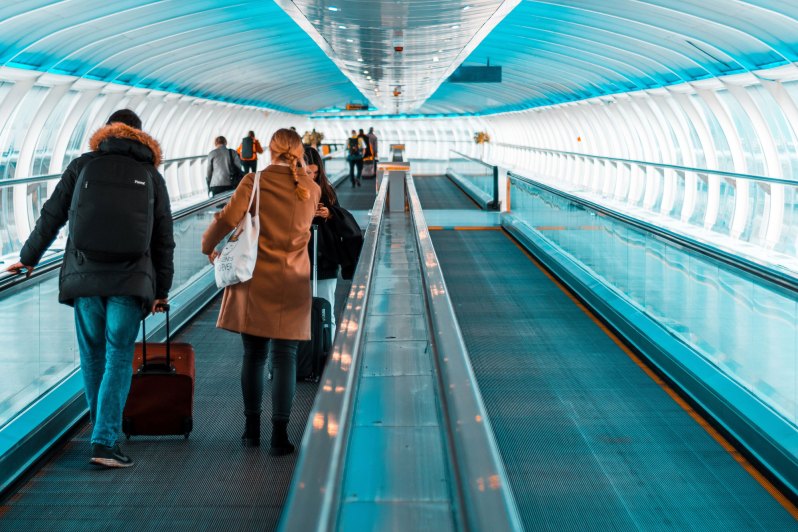Accessories are an essential and much-loved part of the modern air travel experience. From neck pillows to tangle-free headphones to TSA-friendly skincare products, every year we’re bombarded with endless articles and listicles for the “Top Travel Accessories” or “20 Essential Accessories Every Traveler Must Have,” which we all dutifully buy and add to our ensemble. While most of these items are nice enough and in small ways can make flights more comfortable and endurable, the true value of travel accessories is in what they imply about the people who buy and use them. They mark their owner as a jet-setter; someone who’s worldly, sophisticated, and trendy. Someone with discerning taste and cash to spare. In short, a person most people aspire to be.

But, with more and more people traveling every year (globally, 4.3 billion people flew in 2018), yearly flight carbon dioxide emissions topping 860 million metric tons (accounting for about 2% of total greenhouse gas emissions around the globe), and the increasing (and justified) pressure to either curb our flying habits or find some way to make them more sustainable, carbon offsets have emerged as one of the easiest solutions to immediately reducing your personal carbon footprint.
So, if we’re talking along the lines of one item that every traveler should make sure they’re flying with, instead of a new bag or ergonomic neck pillow, it should be carbon offsets. They should be the new, cool, hip travel accessory.
What are carbon offsets?
Essentially, carbon offsets are projects you invest in that, through various methods, reduce or remove carbon dioxide equivalents from the air, thereby balancing out or compensating for the calculated amount of carbon you contribute/put out through activities like flying or driving.
How do carbon offsets work?
To figure out how to offset your emissions from a flight, first, you’d go to a carbon offsetting website; two of the most widely known, used, and vetted are TerraPass and Carbonfund.
These websites have tools that allow you to calculate emissions from a specific flight or multiple flights; there are also options to offset home emissions, lifestyle emissions, vehicles, events, and water usage. For flights, you’d fill out information such as where you were flying from/to, estimated miles, if there were layovers, round-trip or one-way, etc. The calculator then estimates your emissions and gives you the cost.

At some sites like Carbonfund, there are also basic options, such as offsetting flights of up to 10,000 miles (which produce 4,175 lbs CO2) for a flat rate of $20.
Another option is websites like The Climate Trust and Sustainable Travel International where, instead of directly calculating your footprint and emissions and paying based on that, you make general donations to support their offsetting projects.
How much do carbon offsets cost?
One of the biggest unknowns about investing in carbon offsets is how much it costs, with the overall assumption being that it would be prohibitively expensive for the general public to offset their travels. But it’s actually quite affordable and accessible.
Naturally, the cost varies but according to The Guardian, offsetting one ton of carbon dioxide generally costs around $12 dollars. There are many different factors to consider when figuring out the cost of offsetting a flight, like how often you travel, how far, if there are layovers (taking non-stop flights produces fewer emissions), and more.
For example, say you flew round-trip from LAX to LaGuardia. According to TerraPass, that would produce 3,185 lbs of CO2e (carbon dioxide equivalent, the standard measurement unit for carbon footprints). The offset cost would be $15.89. Totally reasonable.

And through sites like Carbonfund, it’s even tax-deductible, meaning that offsetting those flights is not only good for the planet, but it’s also good for your finances.
Some sites also offer carbon offsets as gifts or even as monthly subscriptions, which are great if you travel a lot and don’t want the hassle of figuring out your emissions every month. (Or, if you have $16,320 laying around, you can offset your entire life.)
What kind of carbon offsetting programs are there?
There are all sorts of different projects or ways carbon can be offset, ranging from environmental initiatives like planting trees to large-scale emissions trading schemes, where carbon is traded like credits.
Some of the most popular and well-known initiatives are, of course, forestry projects, namely protection and reforestation, which directly remove CO2 from the air. But there are also renewable energy projects (like wind or solar farms), clean energy technologies, and carbon captures like capturing methane from escaping landfills and discontinued coal mines.

Many projects also aim to provide sustainable living solutions in less economically developed countries and regions; one example is Carbonfund’s Aqua Clara Water Filtration program, which provides residents of rural Kenya with bio-sand water filters to prevent deforestation (so the forest isn’t being chopped down for fire-fuel to boil and purify water) and cut back on emissions.
In some cases, you can do your own research and invest in specific projects you believe in and support, or, through sites like Carbonfund, you make a general payment which goes to support many different carbon reduction projects that the site invests in.
Do carbon offsets actually work?
Yes and no. There are significant and legitimate criticisms of carbon offsetting as a practice, including that it allows people to absolve themselves of a guilty conscience and continue carrying on without actually changing their ways for the long-term health of the planet, and there are questions about whether the projects you’re investing in actually deliver on their promises.
There are some things you can do to ensure you’re supporting causes and organizations that are trustworthy and that follow through on their carbon reductions. Doing your own research is number one. There have also emerged a number of certification standards in recent years, like the Voluntary Gold Standard and Voluntary Carbon Standard, which audit and judge organizations and projects on the basis of rigorous industry criteria.
As for the question of whether carbon offsetting is just letting us off easy instead of actually making us change our ways or tackle the problems of carbon emissions and climate change, that’s ultimately up to you. If you are even considering carbon offsets, it means you’re aware of the impact your life and travel habits have on the planet and you want to do better. Carbon offsetting is one way to try to balance the scales while larger-scale changes are in the works, but (and some offsetting projects say this is true of their clients) using carbon offsets should also encourage more awareness and motivate changes in daily life or travel habits (like paying more for the nonstop flight).
It’s a complicated issue but at the end of the day, it is better than doing nothing and a lot of good can come out of it, such as the preservation of our forests and trees, entrepreneurship in the creation of new clean energy projects, and in spurring consideration of your own impact and how to reduce it.

If you really want to ensure some difference is being made (and if you can afford to), you can even double or triple offset your flights so that the scales aren’t just even, they’re tipped in the planet’s favor.
Why should I spend my money on carbon offsets?
As mentioned above, certain travel accessories act as a sort of cachet or status symbol, giving their owners an aura of accomplishment and prestige.
Well, we need to give carbon offsets that same vibe. They are essential. They are trendy and hip. They are a must. Every cool jet-setter you see chilling in the airport bar uses them, or should; and every frequent flier compares their different projects the same way we now compare airline rewards points or travel credit cards. Let’s be honest: None of us want to stop traveling because getting to see the world, experience new cultures, and try new things is wonderful. So we need to figure out a way to be more sustainable about it. While large-scale cultural and societal shifts need to be made, carbon offsets are a step in the right direction.
So, this year, instead of buying another neck pillow or the latest newfangled travel gadget, put those dollars toward minimizing your impact and investing in carbon offsets. Let’s make being accountable for our travel emissions as cool as showing off those vacation pics on Instagram. Let’s make it a bragging right, something we casually humble-brag about on social media. Let’s make carbon offsets the ultimate travel accessory — just like those comfortable flats or no-tangle earbuds, you never travel without them.
Editors' Recommendations
- Why travel experts think you should expect airline tickets to get more expensive
- 5 great reasons why you should go to your favorite ski resort this summer
- Holiday travel woes: Why Southwest Airlines descended into chaos this year
- Why COVID-19 ‘Vaccine Passports’ Won’t Change the Face of Travel
- Should You Travel After Getting a COVID-19 Vaccine?



